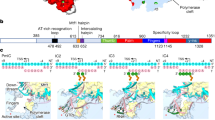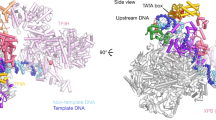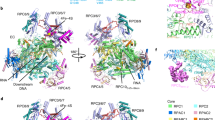Abstract
During gene transcription, RNA polymerase (Pol) II moves forwards along DNA and synthesizes messenger RNA. However, at certain DNA sequences, Pol II moves backwards, and such backtracking can arrest transcription. Arrested Pol II is reactivated by transcription factor IIS (TFIIS), which induces RNA cleavage that is required for cell viability1. Pol II arrest and reactivation are involved in transcription through nucleosomes2,3 and in promoter-proximal gene regulation4,5,6. Here we present X-ray structures at 3.3 Å resolution of an arrested Saccharomyces cerevisiae Pol II complex with DNA and RNA, and of a reactivation intermediate that additionally contains TFIIS. In the arrested complex, eight nucleotides of backtracked RNA bind a conserved ‘backtrack site’ in the Pol II pore and funnel, trapping the active centre trigger loop and inhibiting mRNA elongation. In the reactivation intermediate, TFIIS locks the trigger loop away from backtracked RNA, displaces RNA from the backtrack site, and complements the polymerase active site with a basic and two acidic residues that may catalyse proton transfers during RNA cleavage. The active site is demarcated from the backtrack site by a ‘gating tyrosine’ residue that probably delimits backtracking. These results establish the structural basis of Pol II backtracking, arrest and reactivation, and provide a framework for analysing gene regulation during transcription elongation.
This is a preview of subscription content, access via your institution
Access options
Subscribe to this journal
Receive 51 print issues and online access
$199.00 per year
only $3.90 per issue
Buy this article
- Purchase on Springer Link
- Instant access to full article PDF
Prices may be subject to local taxes which are calculated during checkout




Similar content being viewed by others
Accession codes
References
Sigurdsson, S., Dirac-Svejstrup, A. B. & Svejstrup, J. Q. Evidence that transcript cleavage is essential for RNA polymerase II transcription and cell viability. Mol. Cell 38, 202–210 (2010)
Kim, J., Guermah, M. & Roeder, R. G. The human PAF1 complex acts in chromatin transcription elongation both independently and cooperatively with SII/TFIIS. Cell 140, 491–503 (2010)
Kireeva, M. L. et al. Nature of the nucleosomal barrier to RNA polymerase II. Mol. Cell 18, 97–108 (2005)
Adelman, K. et al. Efficient release from promoter-proximal stall sites requires transcript cleavage factor TFIIS. Mol. Cell 17, 103–112 (2005)
Nechaev, S. et al. Global analysis of short RNAs reveals widespread promoter-proximal stalling and arrest of Pol II in Drosophila . Science 327, 335–338 (2010)
Palangat, M., Renner, D. B., Price, D. H. & Landick, R. A negative elongation factor for human RNA polymerase II inhibits the anti-arrest transcript-cleavage factor TFIIS. Proc. Natl Acad. Sci. USA 102, 15036–15041 (2005)
Komissarova, N. & Kashlev, M. RNA polymerase switches between inactivated and activated states by translocating back and forth along the DNA and the RNA. J. Biol. Chem. 272, 15329–15338 (1997)
Nudler, E., Mustaev, A., Lukhtanov, E. & Goldfarb, A. The RNA-DNA hybrid maintains the register of transcription by preventing backtracking of RNA polymerase. Cell 89, 33–41 (1997)
Palangat, M. & Landick, R. Roles of RNA:DNA hybrid stability, RNA structure, and active site conformation in pausing by human RNA polymerase II. J. Mol. Biol. 311, 265–282 (2001)
Wang, D. et al. Structural basis of transcription: backtracked RNA polymerase II at 3.4 angstrom resolution. Science 324, 1203–1206 (2009)
Gnatt, A. L., Cramer, P., Fu, J., Bushnell, D. A. & Kornberg, R. D. Structural basis of transcription: an RNA polymerase II elongation complex at 3.3 A resolution. Science 292, 1876–1882 (2001)
Sluder, A. E., Price, D. H. & Greenleaf, A. L. Elongation by Drosophila RNA Polymerase-II. Transcription of 3′-extended DNA templates. J. Biol. Chem. 263, 9917–9925 (1988)
Johnson, T. L. & Chamberlin, M. J. Complexes of yeast RNA polymerase II and RNA are substrates for TFIIS-induced RNA cleavage. Cell 77, 217–224 (1994)
Gu, W., Powell, W., Mote, J. J. & Reines, D. Nascent RNA cleavage by arrested RNA polymerase II does not require upstream translocation of the elongation complex on DNA. J. Biol. Chem. 268, 25604–25616 (1993)
Izban, M. G. & Luse, D. S. The increment of SII-facilitated transcript cleavage varies dramatically between elongation competent and incompletent RNA polymerase II ternary complexes. J. Biol. Chem. 268, 12874–12885 (1993)
Cramer, P. et al. Architecture of RNA polymerase II and implications for the transcription mechanism. Science 288, 640–649 (2000)
Bar-Nahum, G. et al. A ratchet mechanism of transcription elongation and its control. Cell 120, 183–193 (2005)
Brueckner, F. & Cramer, P. Structural basis of transcription inhibition by alpha-amanitin and implications for RNA polymerase II translocation. Nature Struct. Mol. Biol. 15, 811–818 (2008)
Kettenberger, H., Armache, K.-J. & Cramer, P. Complete RNA polymerase II elongation complex structure and its interactions with NTP and TFIIS. Mol. Cell 16, 955–965 (2004)
Vassylyev, D. G. et al. Structural basis for substrate loading in bacterial RNA polymerase. Nature 448, 163–168 (2007)
Wang, D., Bushnell, D. A., Westover, K. D., Kaplan, C. D. & Kornberg, R. D. Structural basis of transcription: role of the trigger loop in substrate specificity and catalysis. Cell 127, 941–954 (2006)
Markovtsov, V., Mustaev, A. & Goldfarb, A. Protein-RNA interactions in the active center of transcription elongation complex. Proc. Natl Acad. Sci. USA 93, 3221–3226 (1996)
Hawryluk, P. J., Ujvari, A. & Luse, D. S. Characterization of a novel RNA polymerase II arrest site which lacks a weak 3′ RNA-DNA hybrid. Nucleic Acids Res. 32, 1904–1916 (2004)
Sydow, J. F. et al. Structural basis of transcription: mismatch-specific fidelity mechanisms and paused RNA polymerase II with frayed RNA. Mol. Cell 34, 710–721 (2009)
Zenkin, N., Yuzenkova, Y. & Severinov, K. Transcript-assisted transcriptional proofreading. Science 313, 518–520 (2006)
Toulokhonov, I., Zhang, J. W., Palangat, M. & Landick, R. A central role of the RNA polymerase trigger loop in active-site rearrangement during transcriptional pausing. Mol. Cell 27, 406–419 (2007)
Kettenberger, H., Armache, K.-J. & Cramer, P. Architecture of the RNA polymerase II-TFIIS complex and implications for mRNA cleavage. Cell 114, 347–357 (2003)
Sosunov, V. et al. Unified two-metal mechanism of RNA synthesis and degradation by RNA polymerase. EMBO J. 22, 2234–2244 (2003)
Weilbaecher, R. G., Awrey, D. E., Edwards, A. M. & Kane, C. M. Intrinsic transcript cleavage in yeast RNA polymerase II elongation complexes. J. Biol. Chem. 278, 24189–24199 (2003)
Awrey, D. E. et al. Yeast transcript elongation factor TFIIS, structure and function. II: RNA polymerase binding, transcript cleavage, and read-through. J. Biol. Chem. 273, 22595–22605 (1998)
Acknowledgements
We thank F. Brueckner, G. Damsma, K. Kinkelin, D. Kostrewa, L. Larivière, E. Lehmann, F. Martinez, S. Sainsbury and J. Sydow. Part of this work was performed at the Swiss Light Source at the Paul Scherrer Institut, Villigen, Switzerland. P.C. was supported by the Deutsche Forschungsgemeinschaft, SFB646, TR5, FOR1068, NIM, Bioimaging Network BIN, and the Jung-Stiftung.
Author information
Authors and Affiliations
Contributions
A.C.M.C. carried out experiments. P.C. supervised the project. A.C.M.C. and P.C. prepared the manuscript.
Corresponding author
Ethics declarations
Competing interests
The authors declare no competing financial interests.
Supplementary information
Supplementary Information
The file contains Supplementary Tables 1-2, Supplementary Figures 1-3 with legends and additional references. (PDF 523 kb)
Rights and permissions
About this article
Cite this article
Cheung, A., Cramer, P. Structural basis of RNA polymerase II backtracking, arrest and reactivation. Nature 471, 249–253 (2011). https://doi.org/10.1038/nature09785
Received:
Accepted:
Published:
Issue Date:
DOI: https://doi.org/10.1038/nature09785
This article is cited by
-
When push comes to shove - RNA polymerase and DNA-bound protein roadblocks
Biophysical Reviews (2023)
-
Structural insights into nuclear transcription by eukaryotic DNA-dependent RNA polymerases
Nature Reviews Molecular Cell Biology (2022)
-
Cryo-EM structures of human RNA polymerase III in its unbound and transcribing states
Nature Structural & Molecular Biology (2021)
-
Transcriptional processing of an unnatural base pair by eukaryotic RNA polymerase II
Nature Chemical Biology (2021)
-
PHF3 regulates neuronal gene expression through the Pol II CTD reader domain SPOC
Nature Communications (2021)
Comments
By submitting a comment you agree to abide by our Terms and Community Guidelines. If you find something abusive or that does not comply with our terms or guidelines please flag it as inappropriate.



